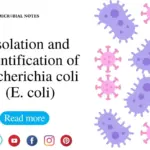Introduction
Scientists Robert Koch studied Bacillus Anthracis, the bacterium that causes anthrax. He discovered that the bacteria formed spores and were able to survive for very long periods and in many different environments. Anthrax is a severe infectious disease affected by Gram-positive, rod-shaped bacteria known as Bacillus Anthracis.
It occurs normally in soil and commonly affects households and wild animals around the world. People can get weak with anthrax if they come, in contact with infected animals or infected animal products. The species name “Anthracis” is derived from the name of the disease, anthrax, which in turn is derived from the Greek word for coal, anthrax is due to the formation of black, coal-like cutaneous eschars.
What is the classification of Bacillus Anthracis?
The genus Bacillus belongs to the family Bacillaceae which contains several genera classified based on their phenotypic and molecular characteristics. There are more than 142 different species belonging to the genus Bacillus which are further classified into manageable groups based on their 16S rRNA sequences.
The classification and distinction of B. Anthracis from other members of the group can be made by amplified fragment length polymorphism analysis as they are similar to the 16S rRNA gene sequences. 89 different strains of B.Anthracis have been isolated from different areas throughout the world and are used for different purposes. Bacillus Anthracis is monomorphic and has low genetic diversity along with the absence of any measurable lateral DNA transfer. Some differences, however, might be observed in the lifecycle of the bacteria that revolves between an animal host and the environment.
What is the habitat and morphology of Bacillus Anthracis?
Bacillus anthracis is an aerobic endospore-forming bacterium that occurs in a broad range of natural environments. Even though the bacteria have been insulated from different environments, all of those environments are not considered their habitats. B.Anthracis like other Bacillus species thrives in the soil under both acidic and alkaline conditions within a wide temperature range. Bacillus Anthracis, in the natural environment, outside the body of the host, exists in the form of spores as the environmental condition get difficult. The spores are generally light and can easily distribute through dust or the formation of aerosols.
Bacillus anthracis a Gram-positive, non-a motile, rectangular, aerobic, rod-shaped bacterium with a square measuring about 1micrometer×3-5 micrometers. Chain formation is common. B.anthracis generally grows as planktonic cells in liquid media, although the formation of pellicles during static incubation and adherence to solid surfaces can occur. B.anthracis patterns long serpentine chains during the exponential stage of batch culture. In infected tissues, generally, single cells or short chains of 2-3 cells are examined. The genome nucleotide is organic about 60% adenine.
What is the pathogenesis of Bacillus Anthracis?
The overall pathogenesis of B.anthracis can be characterized in the following steps;
Entry:
The primary infectious of B.anthracis is the spore that enters the body of the host from the environment by different means. The spores are resistant to various environmental conditions and can germinate into vegetative form as the favorable condition becomes available. Macrophages rapidly phagocytose the spores inside the host’s body and some of the spores inside the host’s body and some of the spores undergo lysis in the macrophages.
Other spores, especially those that enter the body via inhalation, survive the phagocytosis and are carried toward the mediastinal lymph nodes by the lymphatic system. Phagocytosis is carried toward the mediastinal lymph nodes by the lymphatic system. The germination is triggered by elevated CO2 levels and the body temperature of the host.
Invasion:
The germination of the spores into vegetative cells is followed by the activation of the capsule and toxin genes present in the plasmids of the organisms. The capsule is implicated in the resistance to phagocytosis as a result of negative charges present on it. The toxins are also released in the form of three different protein components that undergo cleavage and binding to form the toxins ultimately. The edema toxin also has increased host susceptibility to infection by stimulating chemotaxis in human neutrophils. During the early stages of the disease as a result of the synergistic impact of both toxins, removal in the release of pro-inflammatory cytokines occurs, which considerably permits bacterial proliferation in the host. Lethal and edema toxins also can increase susceptibility to infection by stimulating chemotaxis in human neutrophils.
The fatal toxin then cleaves the units of the mitogen-activated protein kinase family interfering with certain signaling pathways and gaining the levels of shocking-inducing cytokines like TNF alpha and IL-1beta. Lethal and edema toxins jointly can also provoke vascular alarm, but the nature of the alarm might differ. As the infection continues, the bacteria make their way into the blood with the terminal levels of bacteria reaching, 107 to 109 cells/ml in susceptible hosts.
What is the clinical Manifestation of Bacillus anthracis?
The infection caused by Bacillus anthracis is called anthrax which exists in three different forms depending on the route of entry of the bacteria. The most common form of anthrax infection is cutaneous anthrax which accounts for about 90% of all human cases. The other two forms of anthrax are gastrointestinal anthrax and pulmonary anthrax. Bacillus anthracis is also associated with meningitis.
Cutaneous Anthrax:
The least dangerous form of anthrax.
Endospores enter through the skin and germinate, causing a localized infection.
Produces a black necrotic lesion with a coal-like factor; this is the source of its name.
This aspect of anthrax is usually easily fixed with antibiotic treatment.
If the bacillus anthracis can enter the bloodstream from the injection site, however, is highly likely to be fatal.
Pulmonary anthrax:
Occurs when endospores are inhaled and germinate in the lungs, leading to infection.
Sometimes called “woolsorter’s disease” due to its association with exposure to animal products such as wool or hides.
Early symptoms can compare to pneumonia or flu.
This can lead to hemorrhaging in the lungs.
Gastrointestinal anthrax:
Occurs when endospores are ingested.
A very rare form of anthrax.
Reported mortality rates vary from 25-75%.
Meningitis:
Meningitis in anthrax happens at the end phase of the other forms of anthrax. The symptoms appear rapidly with a faint, but the progression is quite slow.
The clinical symptoms comprise the aspect of blood in cerebrospinal fluid with eventual failure of shock.
What are the symptoms of Bacillus Anthracis?
The symptoms of bacillus anthracis depend on the type of infection and can take anywhere from 1 day to more than 2 months to appear. All types of anthrax have the capacity, if untreated, to unfold throughout the body and cause serious disease and even death. The following are the symptoms of B. anthracis;
- Fever and chills.
- Chest discomfort
- Shortness of breath.
- Confusion or dizziness.
- Cough.
- Nausea, vomiting, or stomach pain.
- Headache.
- Sweats (often drenching).
What are the diagnoses of Bacillus anthracis?
Following are the lab diagnosis of bacillus anthracis;
Cultural characteristics and biochemical identification:
This method is a conventional method for the identification of bacillus anthracis through growth on selective culture media, hemolysis test, capsule staining, motility testing, and susceptibility to penicillin. For the selective isolation of bacillus anthracis, PLET agar is used, which helps in the identification of Bacillus anthracis. This a test of hemolysis that can be performed on differentiated bacillus anthracis from B.cereus which is beta-hemolytic.
Bacillus anthracis on Nutrient agar(NA):
Depending on the sample, Bacillus anthracis can be grown on different types of growth mediums from a simple medium like Nutrient agar to a more complex and selective medium like PLET agar. The colonies of Bacillus anthracis are similar to that of other members of the B.cereus group and must require an additional technique for species-level identification. On NA, colonies of bacillus anthracis appear circular to irregular.
The colonies are white to cream-colored with large sizes (2-7mm in diameter), but the size of the young colonies can be smaller. Colonies of Bacillus anthracis are different from other Bacillus species in that, they form spiking or tailing along the lines of inoculation. Colonies on solid media favor capsule synthesis which results in mucoid colonies with large capsules, resulting in thick colonies.
Bacillus anthracis on Blood agar:
The agar used for the isolation of B. anthracis is prepared by adding 5% sheep blood to nutrient agar. The colonies of B. anthracis are non-hemolytic, which helps in the differentiation of it from other, Bacillus species like B.cereus and B.thuringinesis. The size of colonies are comparatively smaller in Nutrient agar than in Bacillus Species. The size varies between 2-4 mm, but the size might rise on the second day of growth.
Antigen-based methods:
Antigen detection by immunoassay is an alternate approach to the diagnosis of B. anthracis. The choice of victim antigen is dependent on the type of sample being quizzed as different antigens are communicated in the vegetative cells and spores. Common immunoassays used for B. anthracis identification are flow cytometry assays and luminescent adenylate cyclase assays.
Molecular methods:
Molecular methods like PCR involving the DNA identification method facilitate the detection of B. anthracis without the culture of the bacteria, which makes them safer than the conventional methods. The commonly used genetic markers for the identification of B. Anthracis are present in the virulence plasmids, pXO1, and pXO2. The genes utilized contain the coding element of anthrax toxins and the capsule. The detection of these genes also gives data on the virulence of the bacteria. However, there are some challenges with using these genes as the plasmids can be lost or transferred to another Bacillus species.
What is the treatment for Bacillus anthracis infection?
The treatment of anthrax is not very confused as the bacteria is uncomfortable with many antibiotics like ciprofloxacin, erythromycin, penicillin, and vancomycin. It is immune to cephalosporins sulfonamides, and trimethoprim. Penicillin is the drug of choice as friction against penicillin has not been organized in naturally occurring strains. However, the rapid course of the disease even with antibiotic therapy has resulted in high mortality rates for pulmonary anthrax.
Therefore, antitoxin treatments have been studied and used to prevent the rapid progression of the disease and the reduction of toxins. Currently, treatment with ciprofloxacin, amoxicillin, and doxycycline is recommended in cases of mild cases of cutaneous anthrax.
What is the prevention of Bacillus anthracis?
Cases of human-to-human contagion have not been noted in the case of anthrax which implies that the primary form of infection is the spore. Thus, the disease can be avoided by retaining proper hygiene and safety during the handling of infected animals.
Besides, active immunization is essential for anthrax pre-exposure prevention. The only toxin-based vaccine for B.anthrax authorized by FDA is BioThrax. Even though it is thought to be used for pre-exposure prophylaxis as well. Instruments and materials infected used on patients with anthrax should be autoclaved or incinerated as the all method.







